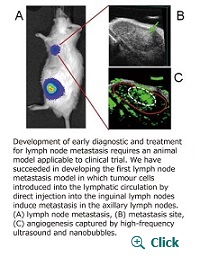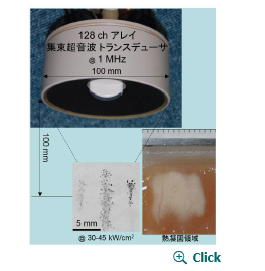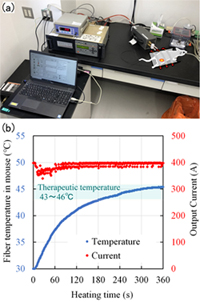Research Subject

-
Preclinical study of early diagnostic and treatment of lymph node metastasis
Tetsuya Kodama, Professor / Shiro Mori, Lecturer(Biomedical Engineering for Cancer)
Most cancer cells are invasive and metastatic, and they become disseminated to distant anatomical site by invasive-metastasis cascade. We will develop diagnosis and treatment methods of lymph node metastasis at the early stages. Our research is interdisciplinary or integrated research based on fluid dynamics, optics, molecular cell biology, oncology, and pathology. Our research subjects are as follows.
1) Mechanisms of lymph node metastasis
2) Drug delivery system (DDS) targeted for lymph node metastasis using nano-particles
3) Assessment of treatment for lymph node metastasis using noninvasive multimodal in vivo imaging techniques such as high-frequency ultrasound, bioluminescence and micro-CT.

-
Noninvasive ultrasonic treatment of non-superficial tissue
Shin Yoshizawa, Associate Professor (Ultrasound Enhanced Nanomedicine)
Microbubbles can highly enhance the therapeutic effect of ultrasound. We are studying ultrasonic methods to generate such microbubbles selectively at the tumor to be treated.
One is to use a highly focused short pulse at an extremely high intensity. Another is to use phase change nanodroplets, which tend to accumulate in tumor tissues due to EPR effect. They are phase-changed to microbubbles by ultrasonic stimulation. The selectivity and throughput of focused ultrasound treatment will be highly enhanced by these methods. We are also studying ultrasonic imaging techniques to aim the target tissue and monitor the therapeutic process.

-
Development of magnetic hyperthermia system for cancer treatment
Shin Yabukami, Professor / Loi Tonthat, Assistant Professor(Biomedical Engineering for Cancer Magnetic Hyperthermia)
Magnetic hyperthermia has gained great interest recently as a promising cancer treatment using heat generation ascribed to magnetic particles placed in a high‐frequency magnetic field to treat cancer. So far, we have been developing core elemental technologies for magnetic hyperthermia and constructing a magnetic hyperthermia system for clinical use using these developed technologies. Our main subjects are as follows.
1) Development of non-invasive position detection technology, temperature detection technology, and therapeutic temperature control technology for magnetic micro/nanoparticles
2) Development of multifunctional magnetic micro/nanoparticles for magnetic hyperthermia and other bio-applications
Figure: (a) Photograph of the developed magnetic hyperthermia system and its animal evaluation experiment. (b) Magnetic nanoparticles (Resovist - liver-specific MRI contrast agent) were injected into mouse, and the temperature at injection site increased to the therapeutic temperature of 43~46℃ by induction heating.


